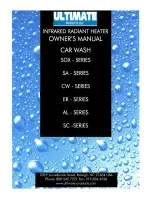
HearthStone Quality Home Heating Products Inc
Tudor Model #8120
19
demand of the unit without undue loss of
pressure. We recommend a flexible line to
avoid undue mechanical load on the valve
and to ease thread alignment, but refer to
local codes.
•
CAUTION: Check Gas Type!
G
AS
S
UPPLY
This appliance and its individual shutoff
valve must be disconnected from the gas
supply piping system during any pressure
testing of that system at test pressures in
excess of ½ psig. The Tudor must be
isolated from the gas supply piping system
by closing its individual manual shutoff
valve during any pressure testing of the gas
supply piping system at test pressures equal
to or greater than ½ psig.
G
AS
P
RESSURE
A
DJUSTMENT
NOTE: A QUALIFIED TECHNICIAN
MUST PERFORM THIS PROCEDURE!
Once connected to the gas supply, the
supply line and manifold gas pressures must
be tested. The supply line pressure is tested,
to insure it meets the minimum gas supply
pressure as listed in the Specifications for
the type of fuel in use (natural gas or LP), by
connecting a manometer to the supply line
and adjusting the incoming pressure if
necessary to meet the required supply line
pressure as listed in specifications. The
manifold pressure tap on the gas control
valve, refer to
Figure 10
for location.
F
IRE
L
OG
P
LACEMENT
CAUTION:
Fragile! Handle log set with
care. Always wear gloves and safety goggles
while handling the log set.
Only the Firelog set supplied with the Tudor
should be placed in the firebox. Do not place
any other logs, wood logs, or other materials
in the firebox. If the log set is damaged or
broken contact your dealer for
replacement.It must be replaced with the
same approved replacement parts. These
components affect the combustion quality
and safety of the heater. The Firelog set will
last a long time, however, they will break if
subjected to rough or improper handling.
Exact positioning of the log set is required in
order to obtain a pleasing flame pattern and
efficient combustion. Incorrect log
placement may cause carbon build-up;
excess thermal stress on the log set and
stove parts, reduced efficiency, and high
levels of carbon monoxide. If the log set
does not set into the firebox exactly as
outlined, contact your dealer for assistance.
I
NSTALLATION OF THE
F
IRE
L
OG
S
ET
1) Open the doors on the front of the unit,
and remove the front cast and glass
assembly. To remove the front, grasp
both sides of the front cast facade, and
lift upward and then outward. The
whole piece is easily removed. Set the
front aside taking care not to chip or
scratch the enamel. Next, locate the
two rotating clips above the glass.
Rotate the clips out of the “locked”
position and tilt the top of the glass
outward. Lift the entire glass assembly
up and out.
2) Gently take the Firelogs out of the
firebox and remove the bubble wrap
from the log set. Be careful not to
damage the log set when unpacking.
There are two logs, a Front and a Rear.
















































